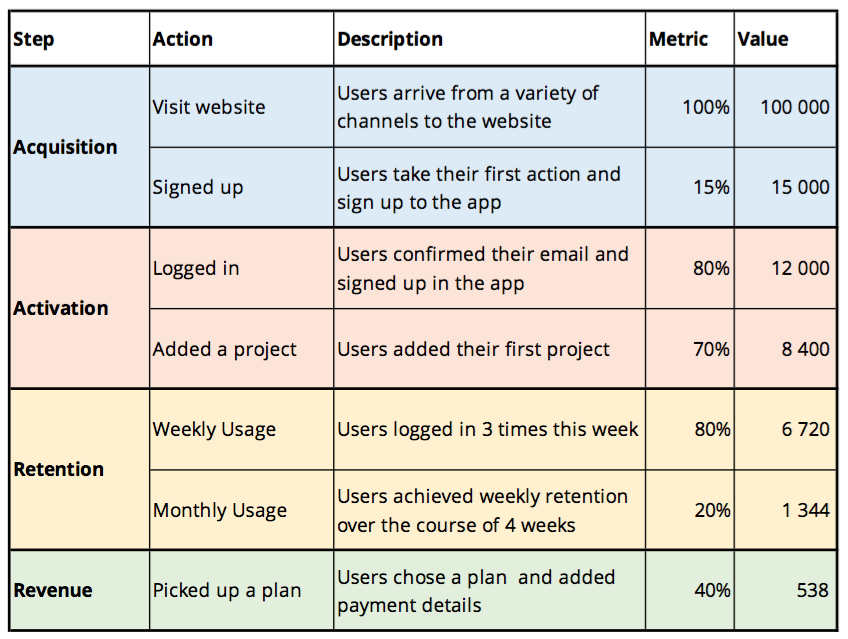Most things we can read about Growth are very operational. You need to run experiments in order to improve your growth. Quid about Strategy? What comes before?
When thinking about Growth, most people think about CRO (Conversion Rate Optimization) on the ToFu (Top of the Funnel). They don’t really understand what is the power of Growth.
To solve this issue, it’s necessary to take a step back and to think about Growth in a strategic way. So, what is a Growth Strategy? How to create one? What are the challenges?
To help you even further, I’ve designed a template you can use to work on your Growth Hacking Strategy. Click here to download it.
Process first?
Getting the strategy right comes before the Growth Hacking Process. You’re trying to identify the area on which you can have the most impact within your limited resources.
When you start with the Process the main issue is that you’ll start brainstorming ideas around every aspect of your business.
You’ll probably brainstorm ideas to bring more people in (Acquisition), make them use your product (Activation) and so on.
You’ll then start to experiment ideas with the most impact.
The result: you’ll lack focus and you won’t move the needle.
Despite your lack of focus, you’ll probably grow your Customer Base, however, your efforts won’t be very effective. You can do much better!
To overcome this issue, we want to design a Growth Strategy beforehand to identify the best areas to focus on.
Strategy
Strategy is a building block of your growth. The aim of the strategy is to:
Create focus & directions within the Growth Team
The strategy is mainly comprised of:
- High-impact areas
- Roadmap
- OKRs (Objective and Key Results)
In other words, you’ll identify the areas where you need to focus on along with the key results that you expect.
Once you’ve done your strategy, you’ll be able to start experimenting on one of your high-impact area with the Growth Hacking Process.
By having a true strategy, you’ll be able to better brainstorm ideas and prioritize them. If you focus on Retention, you’ll be able to say no to experiments on another part of your funnel.
You need to put your Strategy into writing so that it can be available across your whole business. You’ll also avoid changing of focus every week.
Getting your Strategy ready shouldn’t take you months. You want to move the needle, you don’t want to spend too much time here. Just spend enough time to identenfy where you can have the most impact.
You don’t need a 10-pages long document, 1-2 pages or 2-3 slides are enough. Spend enough time thinking it through but make sure it’s accessible to everyone.
Getting your strategy ready beforehand is the first step of your Growth’s sucess. You’ll give focus and directions to your entire team and make sure your efforts aren’t going to waste.
How to define a strategy?
Gather Insight
In order to define a winning strategy, you need to gather insight around your product and consumers.
You need to gather 2 different kinds of insight:
- Qualitative by talking to your customers & prospects
- Quantitative by looking at your metrics and surveying your user base
It can also be helpful to define your Growth model so that you can have a look at the bigger picture.

In this section, understand your funnel (e.g. AARRR) and the metrics of each step.
You need to go through your key issues and start understanding why it doesn’t work and how you can make it better.
Let’s take an example:
- You discover you have a Retention problem: most of your users Churn after 120 days
- “Let’s work on Retention!”
- What if people are actually done with their job after 120 days? Your problem of Retention is built within your product…
At the end of this part, you should be able to understand your funnel and get the true reasons behind each problem.
Identify High-Impact Areas
You should now be able to clearly identify your weaknesses and strengths.
List out each step of your funnel along with the key metrics. You could use the following template making use of the AARRR framework:

Once you know each steps and their metrics, you can easily identify where users are dropping off and where you can have impact.
Your weaknesses should appear quite obvious:
- Are most people dropping-off before they can even see your product?
- Are people never coming back after their first visit?


0 commentaires:
Enregistrer un commentaire